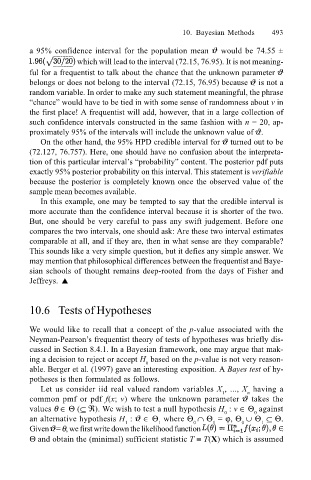Page 516 - Probability and Statistical Inference
P. 516
10. Bayesian Methods 493
a 95% confidence interval for the population mean would be 74.55 ±
which will lead to the interval (72.15, 76.95). It is not meaning-
ful for a frequentist to talk about the chance that the unknown parameter
belongs or does not belong to the interval (72.15, 76.95) because is not a
random variable. In order to make any such statement meaningful, the phrase
chance would have to be tied in with some sense of randomness about v in
the first place! A frequentist will add, however, that in a large collection of
such confidence intervals constructed in the same fashion with n = 20, ap-
proximately 95% of the intervals will include the unknown value of .
On the other hand, the 95% HPD credible interval for turned out to be
(72.127, 76.757). Here, one should have no confusion about the interpreta-
tion of this particular intervals probability content. The posterior pdf puts
exactly 95% posterior probability on this interval. This statement is verifiable
because the posterior is completely known once the observed value of the
sample mean becomes available.
In this example, one may be tempted to say that the credible interval is
more accurate than the confidence interval because it is shorter of the two.
But, one should be very careful to pass any swift judgement. Before one
compares the two intervals, one should ask: Are these two interval estimates
comparable at all, and if they are, then in what sense are they comparable?
This sounds like a very simple question, but it defies any simple answer. We
may mention that philosophical differences between the frequentist and Baye-
sian schools of thought remains deep-rooted from the days of Fisher and
Jeffreys. !
10.6 Tests of Hypotheses
We would like to recall that a concept of the p-value associated with the
Neyman-Pearsons frequentist theory of tests of hypotheses was briefly dis-
cussed in Section 8.4.1. In a Bayesian framework, one may argue that mak-
ing a decision to reject or accept H based on the p-value is not very reason-
0
able. Berger et al. (1997) gave an interesting exposition. A Bayes test of hy-
potheses is then formulated as follows.
Let us consider iid real valued random variables X , ..., X having a
n
1
common pmf or pdf f(x; v) where the unknown parameter takes the
values θ ∈ Θ (⊆ ℜ). We wish to test a null hypothesis H : v ∈ Θ against
0
0
an alternative hypothesis H : ∈ Θ where Θ ∩ Θ = ϕ, Θ ∪ Θ ⊆ Θ.
1
0
1
1
1
0
Given = θ, we first write down the likelihood function
Θ and obtain the (minimal) sufficient statistic T ≡ T(X) which is assumed

